technical data MERCEDES-BENZ GLE COUPE 2015 Owners Manual
[x] Cancel search | Manufacturer: MERCEDES-BENZ, Model Year: 2015, Model line: GLE COUPE, Model: MERCEDES-BENZ GLE COUPE 2015Pages: 393, PDF Size: 12.71 MB
Page 5 of 393
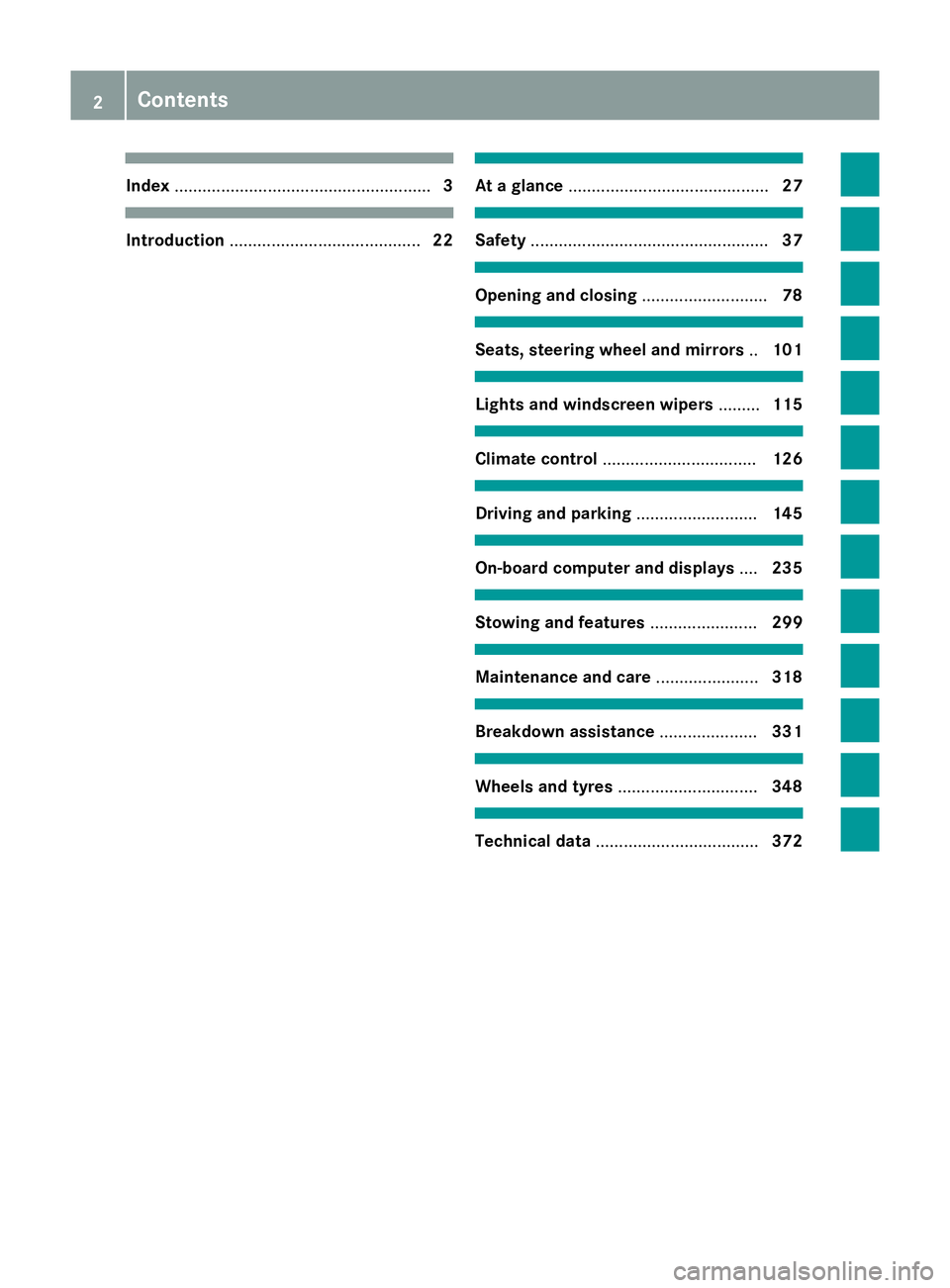
Index
....................................................... 3Introduction
......................................... 22 At a glance
........................................... 27 Safety
................................................... 37 Opening and closing
...........................78 Seats, steering wheel and mirrors
..101 Lights and windscreen wipers
.........115 Climate control
................................. 126 Driving and parking
..........................145 On-board computer and displays
....235 Stowing and features
.......................299 Maintenance and care
......................318 Breakdown assistance
.....................331 Wheels and tyres
.............................. 348 Technical data
................................... 3722
Contents
Page 10 of 393
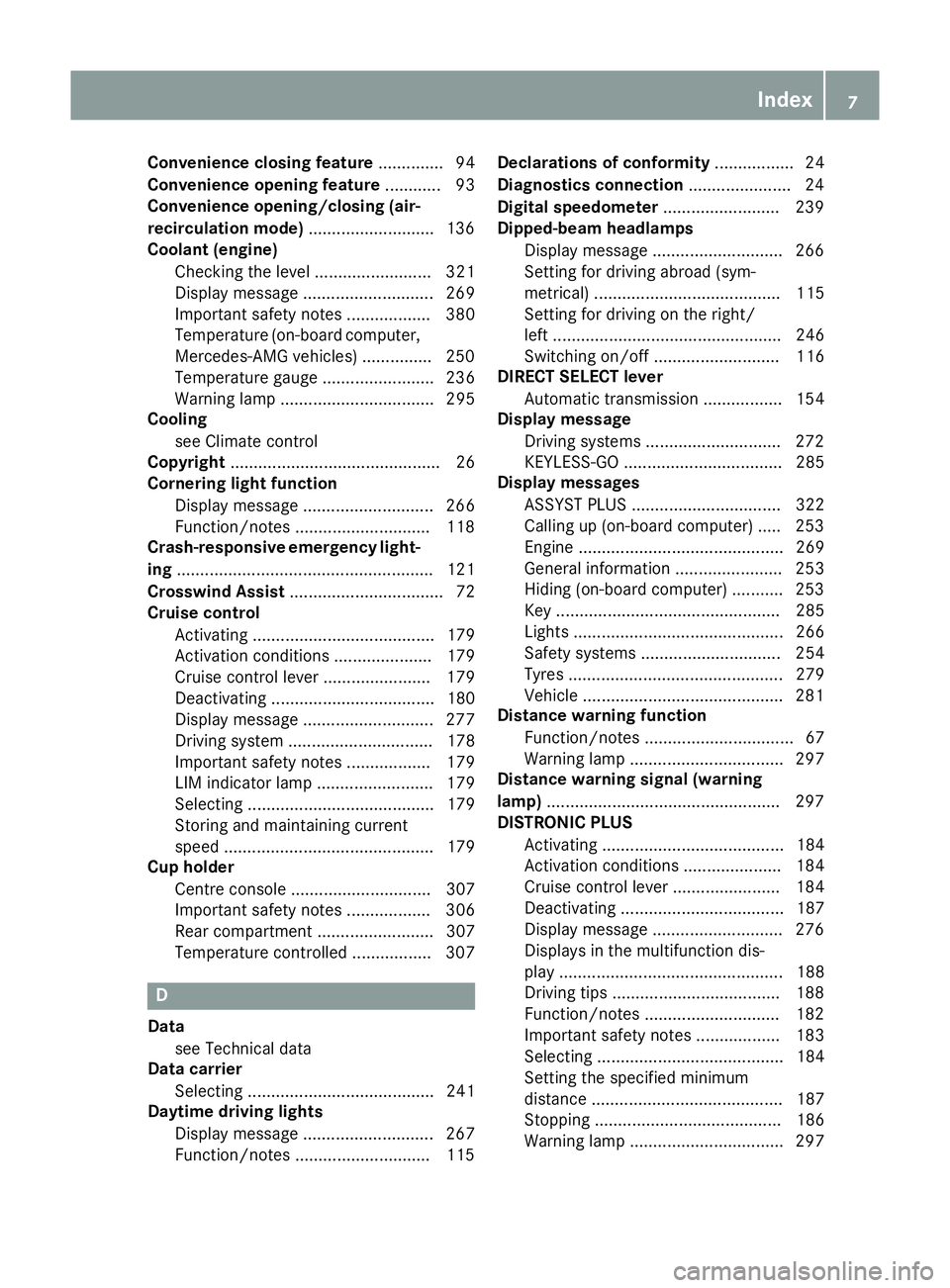
Convenience closing feature
.............. 94
Convenience opening feature ............ 93
Convenience opening/closing (air-
recirculation mode) ...........................136
Coolant (engine)
Checking the level ......................... 321
Display message ............................ 269
Important safety notes .................. 380
Temperature (on-board computer, Mercedes-AMG vehicles) .............. .250
Temperature gauge ........................ 236
Warning lamp ................................. 295
Cooling
see Climate control
Copyright ............................................. 26
Cornering light function
Display message ............................ 266
Function/notes ............................ .118
Crash-responsive emergency light-
ing ....................................................... 121
Crosswind Assist ................................. 72
Cruise control
Activating ....................................... 179
Activation conditions ..................... 179
Cruise control lever ....................... 179
Deactivating ................................... 180
Display message ............................ 277
Driving system ............................... 178
Important safety notes .................. 179
LIM indicator lamp ......................... 179
Selecting ........................................ 179
Storing and maintaining current
speed ............................................. 179
Cup holder
Centre console .............................. 307
Important safety notes .................. 306
Rear compartment ......................... 307
Temperature controlled ................. 307 D
Data see Technical data
Data carrier
Selecting ........................................ 241
Daytime driving lights
Display message ............................ 267
Function/notes ............................ .115 Declarations of conformity
................. 24
Diagnostics connection ......................24
Digital speedometer .........................239
Dipped-beam headlamps
Display message ............................ 266
Setting for driving abroad (sym-
metrical) ........................................ 115
Setting for driving on the right/
left ................................................. 246
Switching on/off ........................... 116
DIRECT SELECT lever
Automatic transmission ................. 154
Display message
Driving systems ............................ .272
KEYLESS-GO .................................. 285
Display messages
ASSYST PLUS ................................ 322
Calling up (on-board computer) ..... 253
Engine ............................................ 269
General information ....................... 253
Hiding (on-board computer) ........... 253
Key ................................................ 285
Lights ............................................. 266
Safety systems .............................. 254
Tyres .............................................. 279
Vehicle .......................................... .281
Distance warning function
Function/notes ................................ 67
Warning lamp ................................. 297
Distance warning signal (warning
lamp) ................................................. .297
DISTRONIC PLUS
Activating ....................................... 184
Activation conditions ..................... 184
Cruise control lever ....................... 184
Deactivating ................................... 187
Display message ............................ 276
Displays in the multifunction dis-
play ................................................ 188
Driving tips ................................... .188
Function/notes ............................ .182
Important safety notes .................. 183
Selecting ........................................ 184
Setting the specified minimum
distance ......................................... 187
Stopping ........................................ 186
Warning lamp ................................. 297 Index
7
Page 12 of 393
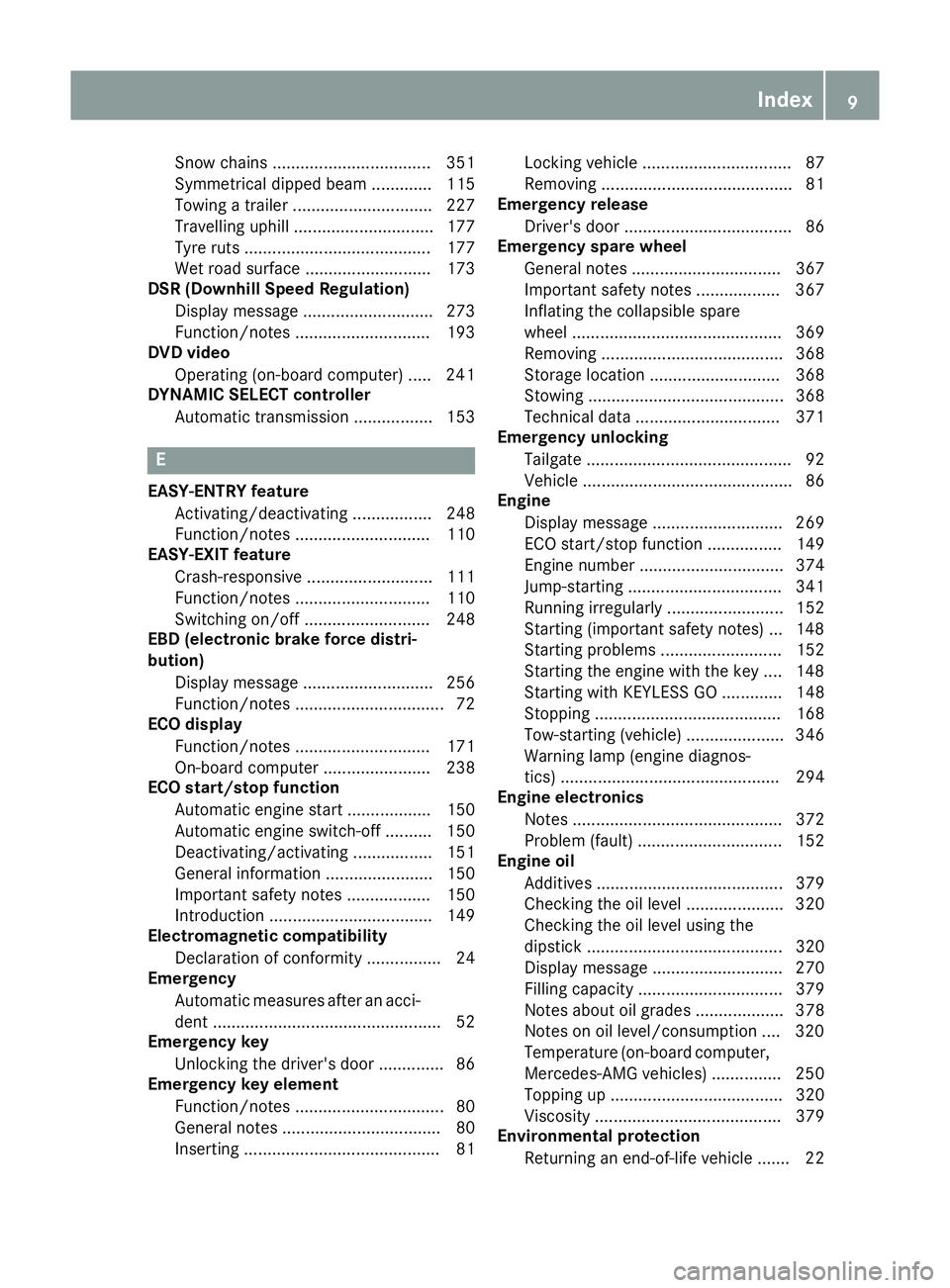
Snow chains .................................. 351
Symmetrical dipped beam ............. 115
Towing a trailer .............................. 227
Travelling uphill .............................. 177
Tyre ruts ........................................ 177
Wet road surface ........................... 173
DSR (Downhill Speed Regulation)
Display message ............................ 273
Function/note s............................. 193
DVD video
Operating (on-board computer) ..... 241
DYNAMIC SELECT controller
Automatic transmission ................. 153 E
EASY-ENTRY feature Activating/deactivating ................. 248
Function/note s............................. 110
EASY-EXIT feature
Crash-responsive ........................... 111
Function/note s............................. 110
Switching on/of f........................... 248
EBD (electronic brake force distri-
bution)
Display message ............................ 256
Function/note s................................ 72
ECO display
Function/note s............................. 171
On-board computer ....................... 238
ECO start/stop function
Automatic engine start .................. 150
Automatic engine switch-off .......... 150
Deactivating/activating ................. 151
General information ....................... 150
Important safety notes .................. 150
Introduction ................................... 149
Electromagnetic compatibility
Declaration of conformity ................ 24
Emergency
Automatic measures after an acci-
dent ................................................. 52
Emergency key
Unlocking the driver's door .............. 86
Emergency key element
Function/note s................................ 80
General notes .................................. 80
Inserting .......................................... 81 Locking vehicle ................................ 87
Removing ......................................... 81
Emergency release
Driver's door .................................... 86
Emergency spare wheel
General notes ................................ 367
Important safety notes .................. 367
Inflating the collapsible spare
wheel ............................................. 369
Removing ....................................... 368
Storage location ............................ 368
Stowing .......................................... 368
Technical data ............................... 371
Emergency unlocking
Tailgate ............................................ 92
Vehicle ............................................. 86
Engine
Display message ............................ 269
ECO start/stop function ................ 149
Engine number ............................... 374
Jump-starting ................................. 341
Running irregularly ......................... 152
Starting (important safety notes )... 148
Starting problems .......................... 152
Starting the engine with the key .... 148
Starting with KEYLESS GO ............. 148
Stopping ........................................ 168
Tow-starting (vehicle) ..................... 346
Warning lamp (engine diagnos-
tics) ............................................... 294
Engine electronics
Notes ............................................. 372
Problem (fault) ............................... 152
Engine oil
Additives ........................................ 379
Checking the oil level ..................... 320
Checking the oil level using the
dipstick .......................................... 320
Display message ............................ 270
Filling capacity ............................... 379
Notes about oil grade s................... 378
Notes on oil level/consumption .... 320
Temperature (on-board computer,
Mercedes-AMG vehicles) ............... 250
Topping up ..................................... 320
Viscosity ........................................ 379
Environmental protection
Returning an end-of-life vehicle ....... 22 Index
9
Page 21 of 393
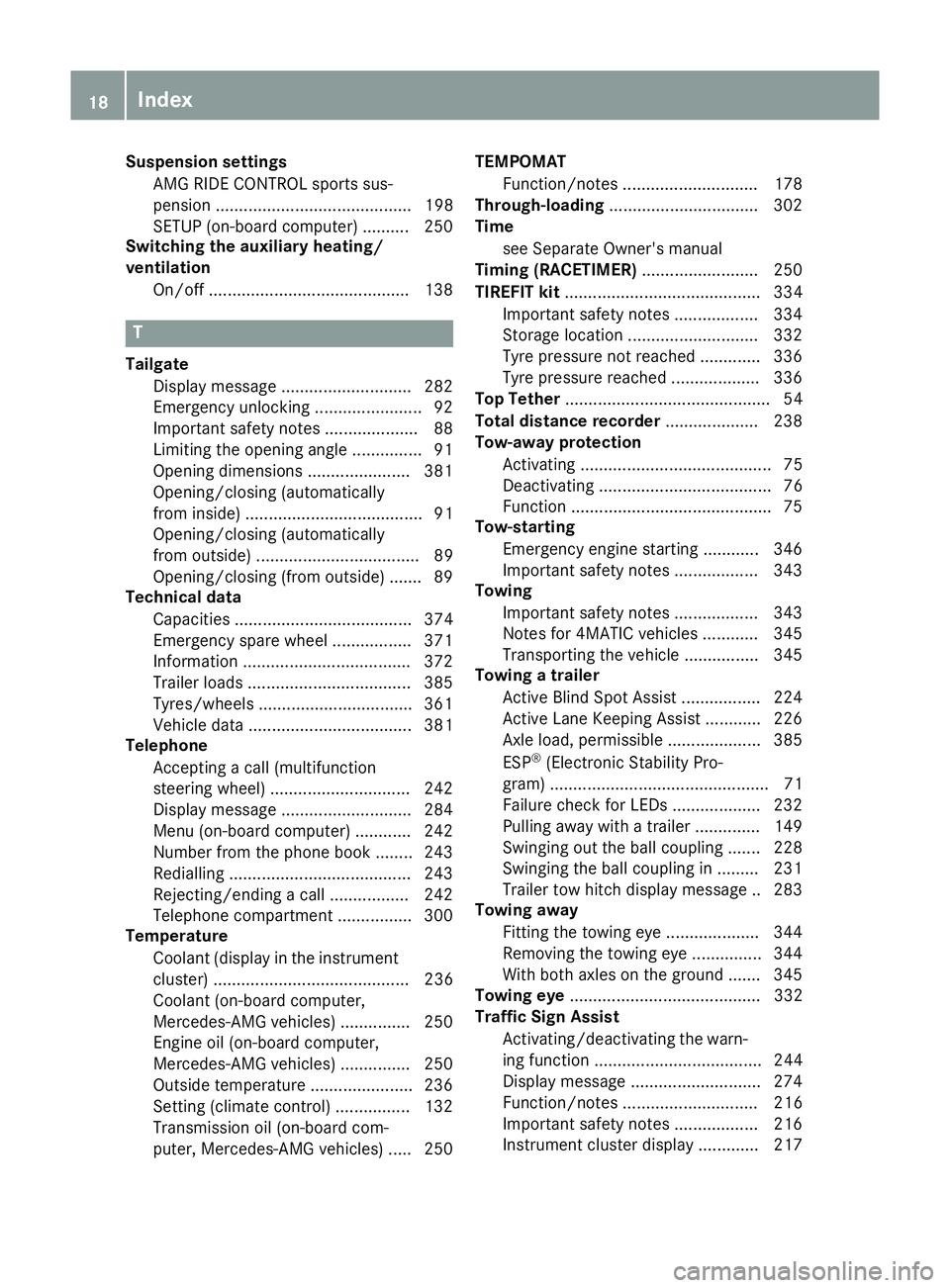
Suspension settings
AMG RIDE CONTROL sports sus-
pension .......................................... 198
SETUP (on-board computer) ..........2 50
Switching the auxiliary heating/
ventilation
On/off .......................................... .138 T
Tailgate Display message ............................ 282
Emergency unlocking ....................... 92
Important safety notes .................... 88
Limiting the opening angle .............. .91
Opening dimensions ......................3 81
Opening/closing (automatically
from inside) ...................................... 91
Opening/closing (automatically
from outside) ................................... 89
Opening/closing (from outside) ....... 89
Technical data
Capacities ...................................... 374
Emergency spare wheel ................. 371
Information ................................... .372
Trailer loads ................................... 385
Tyres/wheels ................................. 361
Vehicle data ................................... 381
Telephone
Accepting a call (multifunction
steering wheel) .............................. 242
Display message ............................ 284
Menu (on-board computer) ............ 242
Number from the phone book ....... .243
Redialling ....................................... 243
Rejecting/ending a call ................. 242
Telephone compartment ................ 300
Temperature
Coolant (display in the instrumentcluster) .......................................... 236
Coolant (on-board computer,
Mercedes-AMG vehicles) .............. .250
Engine oil (on-board computer,
Mercedes-AMG vehicles) .............. .250
Outside temperature ..................... .236
Setting (climate control) ................ 132
Transmission oil (on-board com-
puter, Mercedes-AMG vehicles) ..... 250 TEMPOMAT
Function/notes ............................ .178
Through-loading ................................ 302
Time
see Separate Owner's manual
Timing (RACETIMER) ......................... 250
TIREFIT kit .......................................... 334
Important safety notes .................. 334
Storage location ............................ 332
Tyre pressure not reached ............. 336
Tyre pressure reached ................... 336
Top Tether ............................................ 54
Total distance recorder .................... 238
Tow-away protection
Activating ......................................... 75
Deactivating ..................................... 76
Function .......................................... .75
Tow-starting
Emergency engine starting ............ 346
Important safety notes .................. 343
Towing
Important safety notes .................. 343
Notes for 4MATIC vehicles ............ 345
Transporting the vehicle ................ 345
Towing a trailer
Active Blind Spot Assist ................. 224
Active Lane Keeping Assist ............ 226
Axle load, permissibl e.................... 385
ESP ®
(Electronic Stability Pro-
gram) ............................................... 71
Failure check for LEDs ................... 232
Pulling away with a traile r.............. 149
Swinging out the ball coupling ....... 228
Swinging the ball coupling in ......... 231
Trailer tow hitch display message .. 283
Towing away
Fitting the towing ey e.................... 344
Removing the towing eye ............... 344
With both axles on the ground ....... 345
Towing eye ......................................... 332
Traffic Sign Assist
Activating/deactivating the warn-ing function .................................... 244
Display message ............................ 274
Function/note s............................. 216
Important safety notes .................. 216
Instrument cluster display ............. 217 18
Index
Page 28 of 393
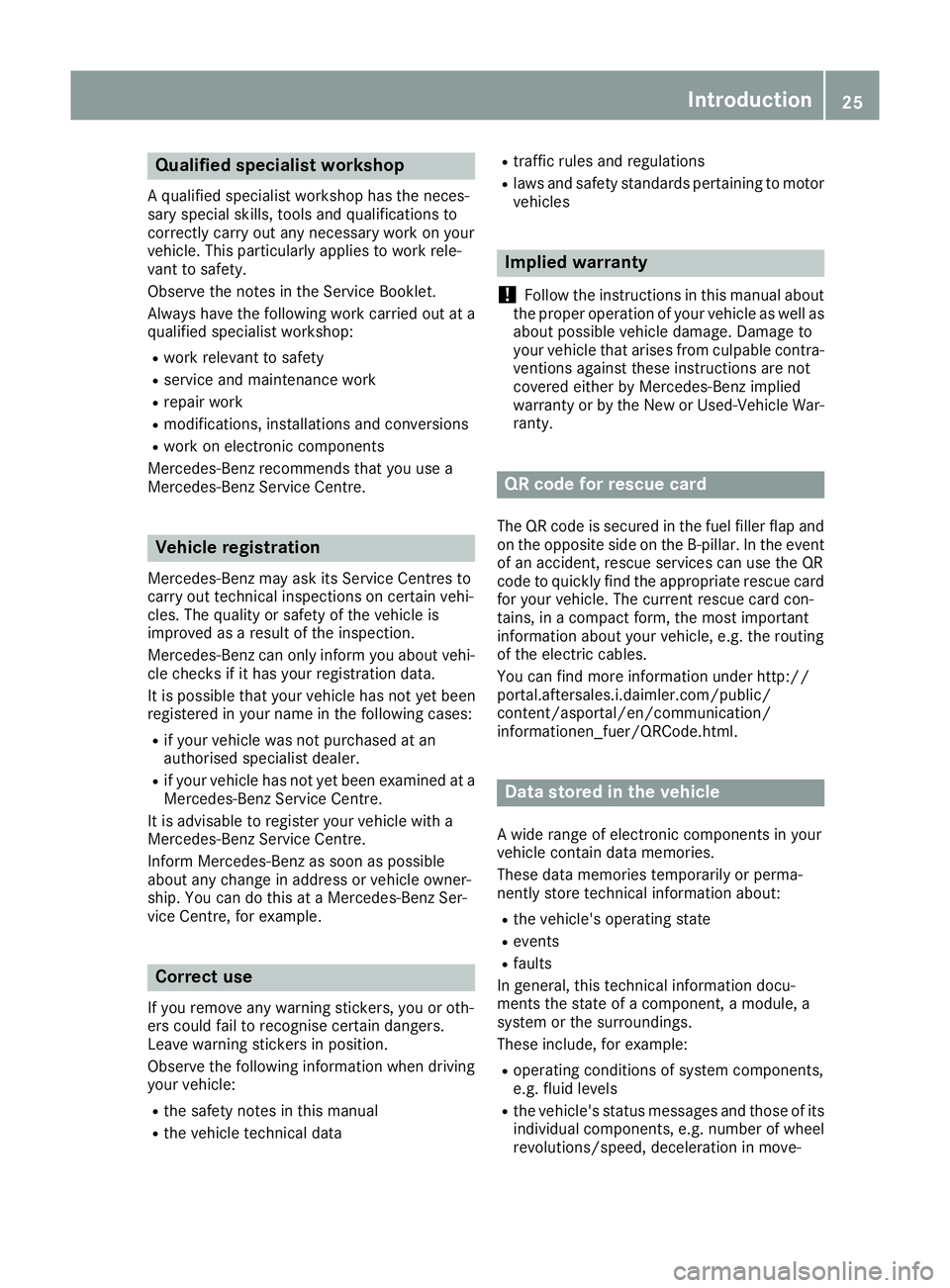
Qualified specialist workshop
A qualified specialist workshop has the neces-
sary special skills, tools and qualifications to
correctly carry out any necessary work on your
vehicle. This particularly applies to work rele-
vant to safety.
Observe the notes in the Service Booklet.
Always have the following work carried out at a
qualified specialist workshop:
R work relevant to safety
R service and maintenance work
R repair work
R modifications, installations and conversions
R work on electronic components
Mercedes-Benz recommends that you use a
Mercedes-Benz Service Centre. Vehicle registration
Mercedes-Benz may ask its Service Centres to
carry out technical inspections on certain vehi-
cles. The quality or safety of the vehicle is
improved as a result of the inspection.
Mercedes-Benz can only inform you about vehi-
cle checks if it has your registration data.
It is possible that your vehicle has not yet been
registered in your name in the following cases:
R if your vehicle was not purchased at an
authorised specialist dealer.
R if your vehicle has not yet been examined at a
Mercedes-Benz Service Centre.
It is advisable to register your vehicle with a
Mercedes-Benz Service Centre.
Inform Mercedes-Benz as soon as possible
about any change in address or vehicle owner-
ship. You can do this at a Mercedes-Benz Ser-
vice Centre, for example. Correct use
If you remove any warning stickers, you or oth-
ers could fail to recognise certain dangers.
Leave warning stickers in position.
Observe the following information when driving your vehicle:
R the safety notes in this manual
R the vehicle technical data R
traffic rules and regulations
R laws and safety standards pertaining to motor
vehicles Implied warranty
! Follow the instructions in this manual about
the proper operation of your vehicle as well as
about possible vehicle damage. Damage to
your vehicle that arises from culpable contra- ventions against these instructions are not
covered either by Mercedes-Benz implied
warranty or by the New or Used-Vehicle War-
ranty. QR code for rescue card
The QR code is secured in the fuel filler flap and
on the opposite side on the B-pillar. In the event
of an accident, rescue services can use the QR
code to quickly find the appropriate rescue card for your vehicle. The current rescue card con-
tains, in a compact form, the most important
information about your vehicle, e.g. the routing
of the electric cables.
You can find more information under http://
portal.aftersales.i.daimler.com/public/
content/asportal/en/communication/
informationen_fuer/QRCode.html. Data stored in the vehicle
A wide range of electronic components in your
vehicle contain data memories.
These data memories temporarily or perma-
nently store technical information about:
R the vehicle's operating state
R events
R faults
In general, this technical information docu-
ments the state of a component, a module, a
system or the surroundings.
These include, for example:
R operating conditions of system components,
e.g. fluid levels
R the vehicle's status messages and those of its
individual components, e.g. number of wheelrevolutions/speed, deceleration in move- Introduction
25 Z
Page 29 of 393
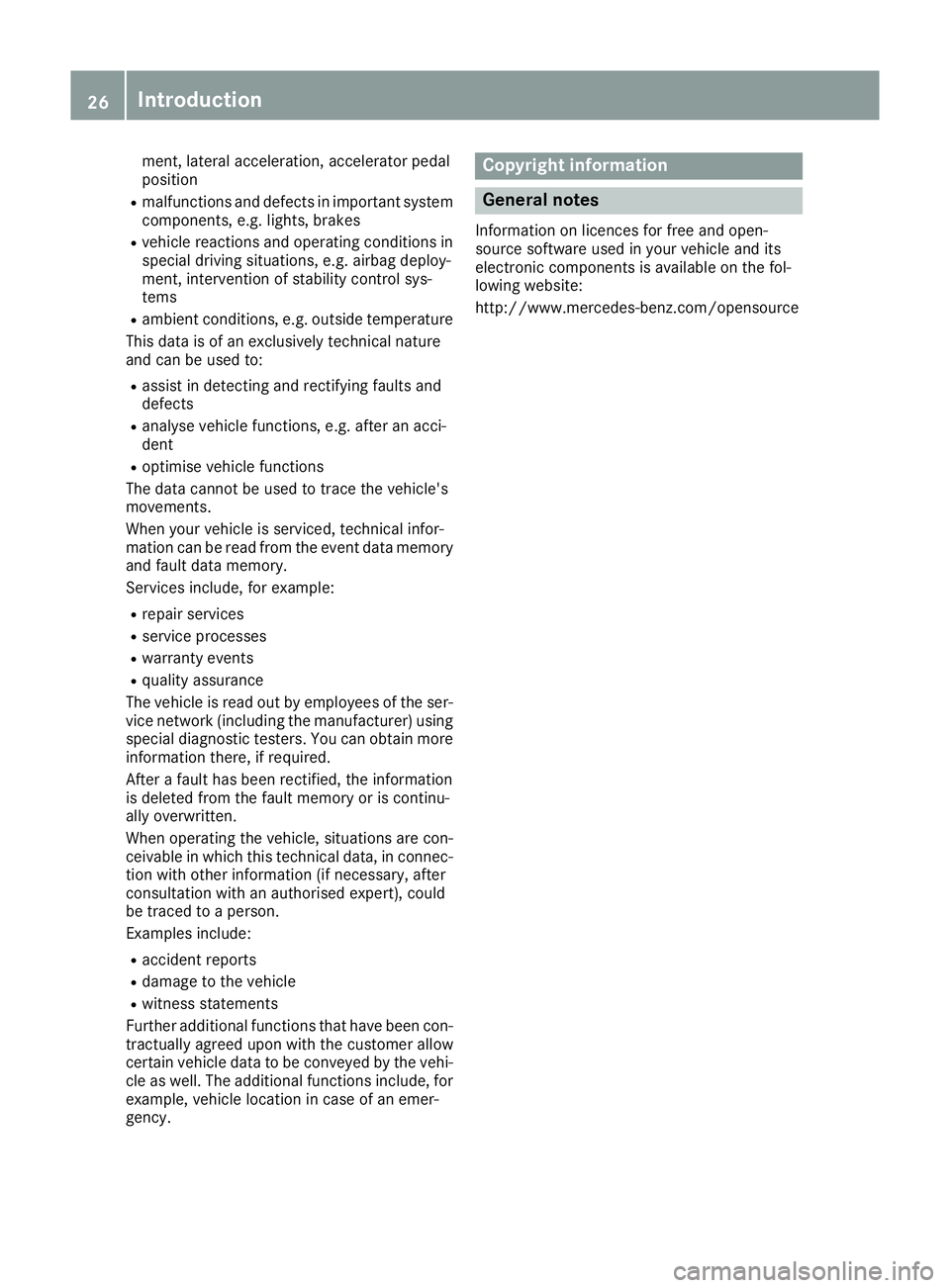
ment, lateral acceleration, accelerator pedal
position
R malfunctions and defects in important system
components, e.g. lights, brakes
R vehicle reactions and operating conditions in
special driving situations, e.g. airbag deploy-
ment, intervention of stability control sys-
tems
R ambient conditions, e.g. outside temperature
This data is of an exclusively technical nature
and can be used to:
R assist in detecting and rectifying faults and
defects
R analyse vehicle functions, e.g. after an acci-
dent
R optimise vehicle functions
The data cannot be used to trace the vehicle's
movements.
When your vehicle is serviced, technical infor-
mation can be read from the event data memory and fault data memory.
Services include, for example:
R repair services
R service processes
R warranty events
R quality assurance
The vehicle is read out by employees of the ser- vice network (including the manufacturer) using
special diagnostic testers. You can obtain more
information there, if required.
After a fault has been rectified, the information
is deleted from the fault memory or is continu-
ally overwritten.
When operating the vehicle, situations are con-
ceivable in which this technical data, in connec- tion with other information (if necessary, after
consultation with an authorised expert), could
be traced to a person.
Examples include:
R accident reports
R damage to the vehicle
R witness statements
Further additional functions that have been con- tractually agreed upon with the customer allow
certain vehicle data to be conveyed by the vehi-
cle as well. The additional functions include, for example, vehicle location in case of an emer-
gency. Copyright information
General notes
Information on licences for free and open-
source software used in your vehicle and its
electronic components is available on the fol-
lowing website:
http://www.mercedes-benz.com/opensource 26
Introduction
Page 230 of 393
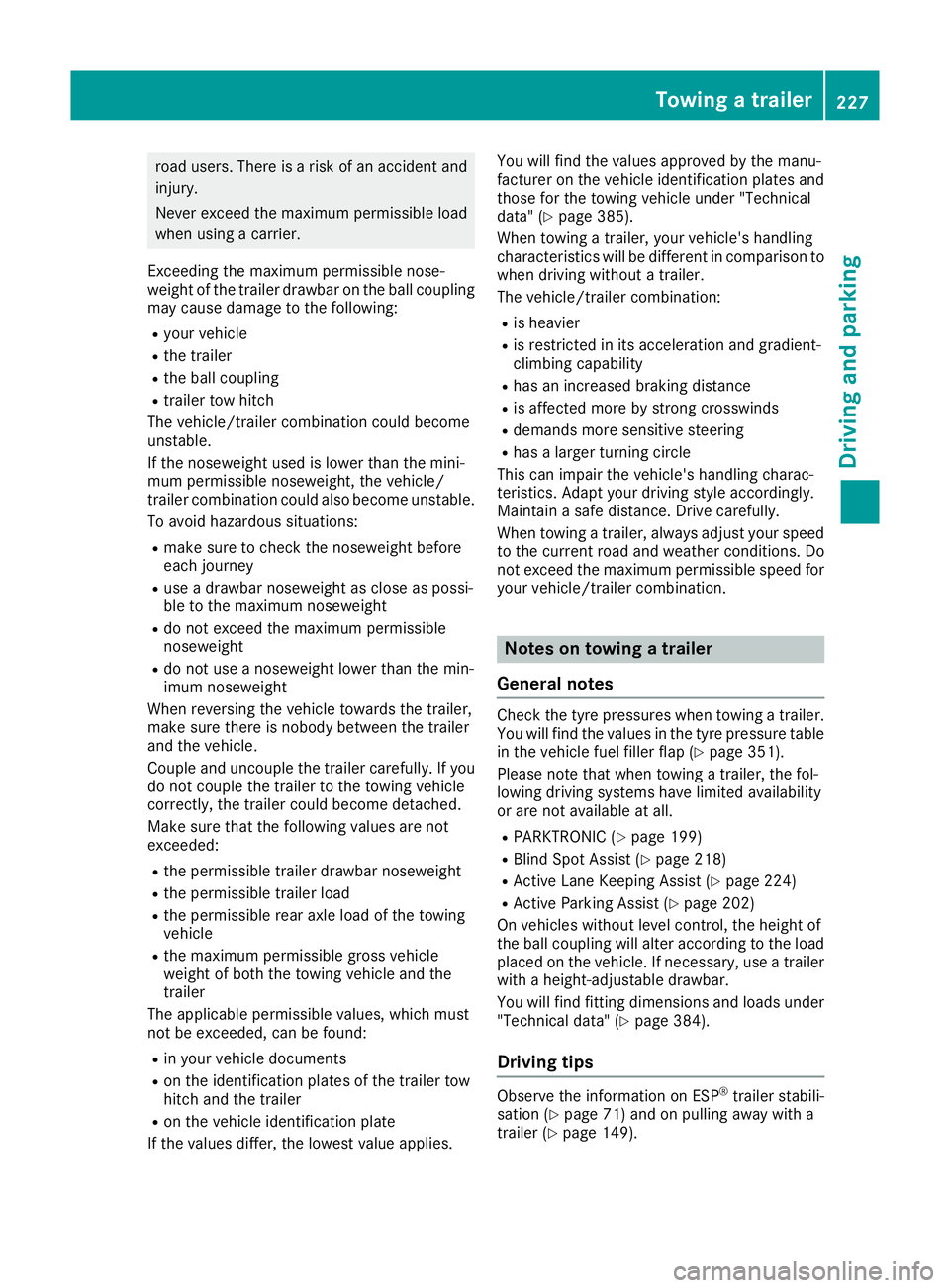
road users. There is a risk of an accident and
injury.
Never exceed the maximum permissible load
when using a carrier.
Exceeding the maximum permissible nose-
weight of the trailer drawbar on the ball coupling may cause damage to the following:
R your vehicle
R the trailer
R the ball coupling
R trailer tow hitch
The vehicle/trailer combination could become
unstable.
If the noseweight used is lower than the mini-
mum permissible noseweight, the vehicle/
trailer combination could also become unstable. To avoid hazardous situations:
R make sure to check the noseweight before
each journey
R use a drawbar noseweight as close as possi-
ble to the maximum noseweight
R do not exceed the maximum permissible
noseweight
R do not use a noseweight lower than the min-
imum noseweight
When reversing the vehicle towards the trailer,
make sure there is nobody between the trailer
and the vehicle.
Couple and uncouple the trailer carefully. If you
do not couple the trailer to the towing vehicle
correctly, the trailer could become detached.
Make sure that the following values are not
exceeded:
R the permissible trailer drawbar noseweight
R the permissible trailer load
R the permissible rear axle load of the towing
vehicle
R the maximum permissible gross vehicle
weight of both the towing vehicle and the
trailer
The applicable permissible values, which must
not be exceeded, can be found:
R in your vehicle documents
R on the identification plates of the trailer tow
hitch and the trailer
R on the vehicle identification plate
If the values differ, the lowest value applies. You will find the values approved by the manu-
facturer on the vehicle identification plates and those for the towing vehicle under "Technical
data" (Y page 385).
When towing a trailer, your vehicle's handling
characteristics will be different in comparison to
when driving without a trailer.
The vehicle/trailer combination:
R is heavier
R is restricted in its acceleration and gradient-
climbing capability
R has an increased braking distance
R is affected more by strong crosswinds
R demands more sensitive steering
R has a larger turning circle
This can impair the vehicle's handling charac-
teristics. Adapt your driving style accordingly.
Maintain a safe distance. Drive carefully.
When towing a trailer, always adjust your speed to the current road and weather conditions. Do
not exceed the maximum permissible speed for
your vehicle/trailer combination. Notes on towing a trailer
General notes Check the tyre pressures when towing a trailer.
You will find the values in the tyre pressure table in the vehicle fuel filler flap (Y page 351).
Please note that when towing a trailer, the fol-
lowing driving systems have limited availability
or are not available at all.
R PARKTRONIC (Y page 199)
R Blind Spot Assist (Y page 218)
R Active Lane Keeping Assist (Y page 224)
R Active Parking Assist (Y page 202)
On vehicles without level control, the height of
the ball coupling will alter according to the load
placed on the vehicle. If necessary, use a trailer
with a height-adjustable drawbar.
You will find fitting dimensions and loads under "Technical data" (Y page 384).
Driving tips Observe the information on ESP
®
trailer stabili-
sation (Y page 71) and on pulling away with a
trailer (Y page 149). Towing a trailer
227Driving and parking Z
Page 231 of 393
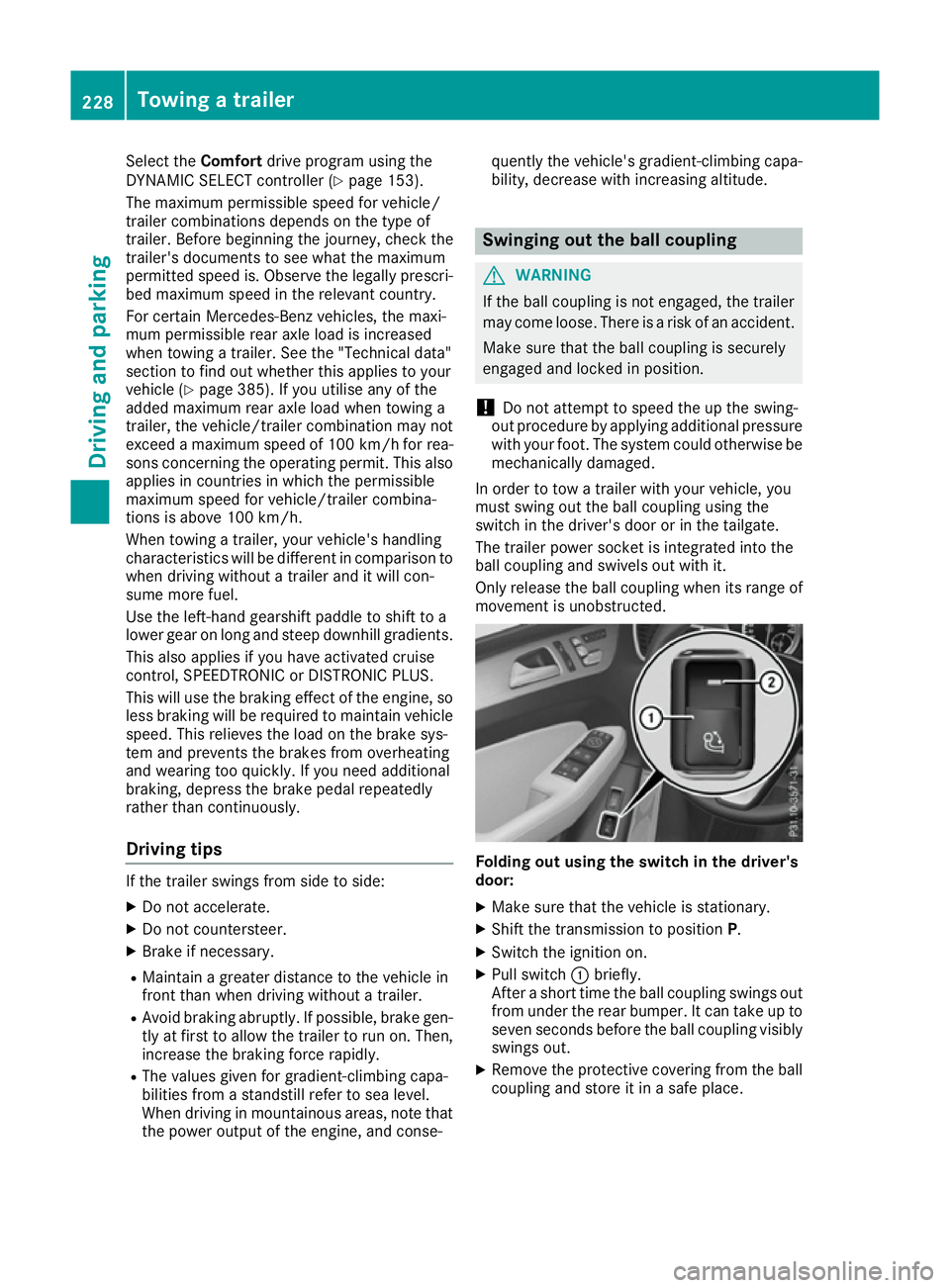
Select the
Comfortdrive program using the
DYNAMIC SELECT controller (Y page 153).
The maximum permissible speed for vehicle/
trailer combinations depends on the type of
trailer. Before beginning the journey, check the
trailer's documents to see what the maximum
permitted speed is. Observe the legally prescri-
bed maximum speed in the relevant country.
For certain Mercedes-Benz vehicles, the maxi-
mum permissible rear axle load is increased
when towing a trailer. See the "Technical data"
section to find out whether this applies to your
vehicle (Y page 385). If you utilise any of the
added maximum rear axle load when towing a
trailer, the vehicle/trailer combination may not
exceed a maximum speed of 100 km/h for rea-
sons concerning the operating permit. This also
applies in countries in which the permissible
maximum speed for vehicle/trailer combina-
tions is above 100 km/h.
When towing a trailer, your vehicle's handling
characteristics will be different in comparison to when driving without a trailer and it will con-
sume more fuel.
Use the left-hand gearshift paddle to shift to a
lower gear on long and steep downhill gradients.
This also applies if you have activated cruise
control, SPEEDTRONIC or DISTRONIC PLUS.
This will use the braking effect of the engine, so
less braking will be required to maintain vehicle
speed. This relieves the load on the brake sys-
tem and prevents the brakes from overheating
and wearing too quickly. If you need additional
braking, depress the brake pedal repeatedly
rather than continuously.
Driving tips If the trailer swings from side to side:
X Do not accelerate.
X Do not countersteer.
X Brake if necessary.
R Maintain a greater distance to the vehicle in
front than when driving without a trailer.
R Avoid braking abruptly. If possible, brake gen-
tly at first to allow the trailer to run on. Then,
increase the braking force rapidly.
R The values given for gradient-climbing capa-
bilities from a standstill refer to sea level.
When driving in mountainous areas, note that
the power output of the engine, and conse- quently the vehicle's gradient-climbing capa-
bility, decrease with increasing altitude. Swinging out the ball coupling
G
WARNING
If the ball coupling is not engaged, the trailer
may come loose. There is a risk of an accident.
Make sure that the ball coupling is securely
engaged and locked in position.
! Do not attempt to speed the up the swing-
out procedure by applying additional pressure
with your foot. The system could otherwise be
mechanically damaged.
In order to tow a trailer with your vehicle, you
must swing out the ball coupling using the
switch in the driver's door or in the tailgate.
The trailer power socket is integrated into the
ball coupling and swivels out with it.
Only release the ball coupling when its range of movement is unobstructed. Folding out using the switch in the driver's
door:
X
Make sure that the vehicle is stationary.
X Shift the transmission to position P.
X Switch the ignition on.
X Pull switch :briefly.
After a short time the ball coupling swings out from under the rear bumper. It can take up to
seven seconds before the ball coupling visibly swings out.
X Remove the protective covering from the ball
coupling and store it in a safe place. 228
Towing a trailerDriving and parking
Page 309 of 393
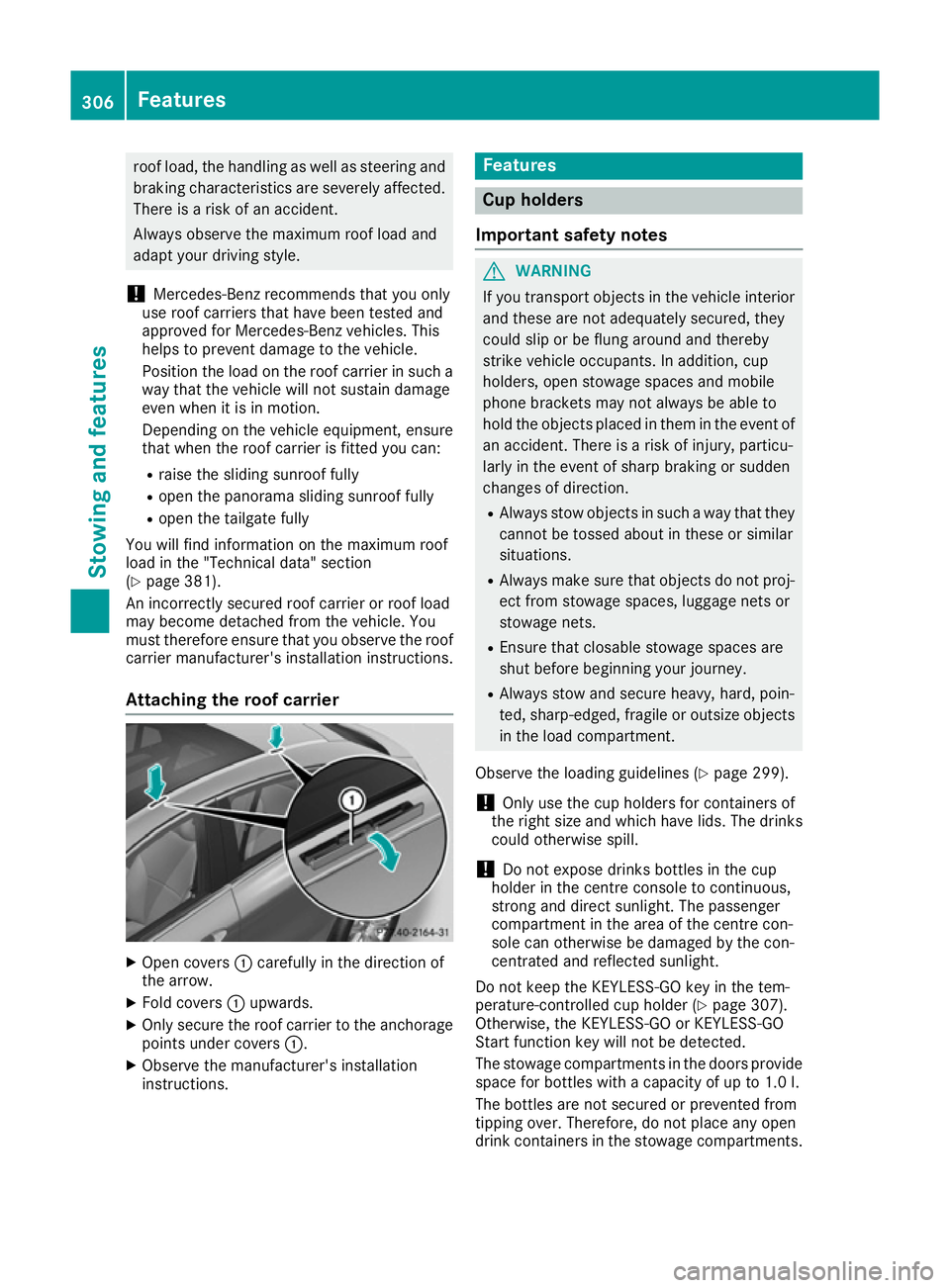
roof load, the handling as well as steering and
braking characteristics are severely affected.
There is a risk of an accident.
Always observe the maximum roof load and
adapt your driving style.
! Mercedes-Benz recommends that you only
use roof carriers that have been tested and
approved for Mercedes-Benz vehicles. This
helps to prevent damage to the vehicle.
Position the load on the roof carrier in such a way that the vehicle will not sustain damage
even when it is in motion.
Depending on the vehicle equipment, ensure
that when the roof carrier is fitted you can:
R raise the sliding sunroof fully
R open the panorama sliding sunroof fully
R open the tailgate fully
You will find information on the maximum roof
load in the "Technical data" section
(Y page 381).
An incorrectly secured roof carrier or roof load
may become detached from the vehicle. You
must therefore ensure that you observe the roof
carrier manufacturer's installation instructions.
Attaching the roof carrier X
Open covers :carefully in the direction of
the arrow.
X Fold covers :upwards.
X Only secure the roof carrier to the anchorage
points under covers :.
X Observe the manufacturer's installation
instructions. Features
Cup holders
Important safety notes G
WARNING
If you transport objects in the vehicle interior and these are not adequately secured, they
could slip or be flung around and thereby
strike vehicle occupants. In addition, cup
holders, open stowage spaces and mobile
phone brackets may not always be able to
hold the objects placed in them in the event of an accident. There is a risk of injury, particu-
larly in the event of sharp braking or sudden
changes of direction.
R Always stow objects in such a way that they
cannot be tossed about in these or similar
situations.
R Always make sure that objects do not proj-
ect from stowage spaces, luggage nets or
stowage nets.
R Ensure that closable stowage spaces are
shut before beginning your journey.
R Always stow and secure heavy, hard, poin-
ted, sharp-edged, fragile or outsize objects
in the load compartment.
Observe the loading guidelines (Y page 299).
! Only use the cup holders for containers of
the right size and which have lids. The drinks
could otherwise spill.
! Do not expose drinks bottles in the cup
holder in the centre console to continuous,
strong and direct sunlight. The passenger
compartment in the area of the centre con-
sole can otherwise be damaged by the con-
centrated and reflected sunlight.
Do not keep the KEYLESS-GO key in the tem-
perature-controlled cup holder (Y page 307).
Otherwise, the KEYLESS-GO or KEYLESS-GO
Start function key will not be detected.
The stowage compartments in the doors provide
space for bottles with a capacity of up to 1.0 l.
The bottles are not secured or prevented from
tipping over. Therefore, do not place any open
drink containers in the stowage compartments. 306
FeaturesStowing and features
Page 327 of 393
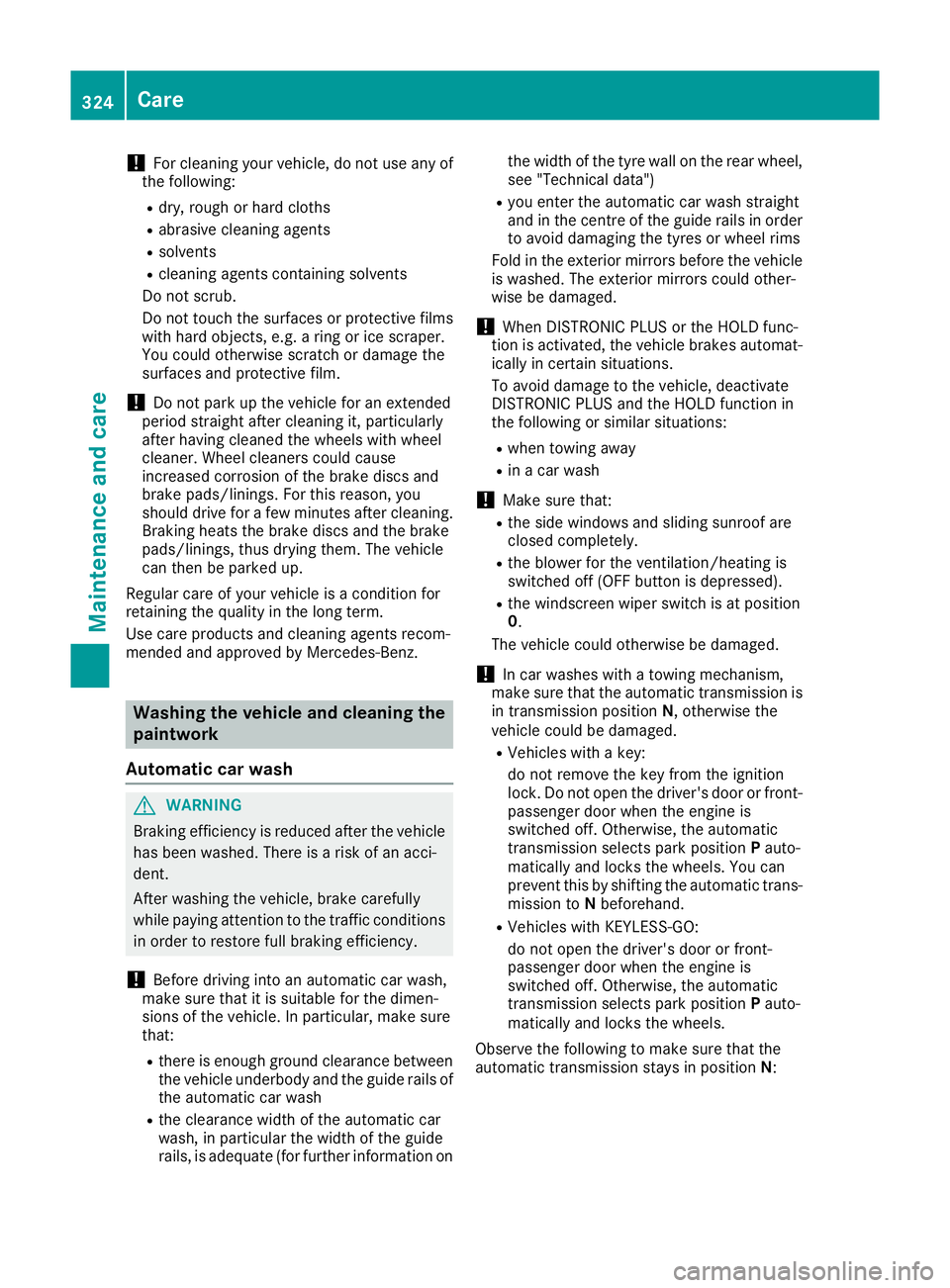
!
For cleaning your vehicle, do not use any of
the following:
R dry, rough or hard cloths
R abrasive cleaning agents
R solvents
R cleaning agents containing solvents
Do not scrub.
Do not touch the surfaces or protective films
with hard objects, e.g. a ring or ice scraper.
You could otherwise scratch or damage the
surfaces and protective film.
! Do not park up the vehicle for an extended
period straight after cleaning it, particularly
after having cleaned the wheels with wheel
cleaner. Wheel cleaners could cause
increased corrosion of the brake discs and
brake pads/linings. For this reason, you
should drive for a few minutes after cleaning. Braking heats the brake discs and the brake
pads/linings, thus drying them. The vehicle
can then be parked up.
Regular care of your vehicle is a condition for
retaining the quality in the long term.
Use care products and cleaning agents recom-
mended and approved by Mercedes-Benz. Washing the vehicle and cleaning the
paintwork
Automatic car wash G
WARNING
Braking efficiency is reduced after the vehicle has been washed. There is a risk of an acci-
dent.
After washing the vehicle, brake carefully
while paying attention to the traffic conditions in order to restore full braking efficiency.
! Before driving into an automatic car wash,
make sure that it is suitable for the dimen-
sions of the vehicle. In particular, make sure
that:
R there is enough ground clearance between
the vehicle underbody and the guide rails of the automatic car wash
R the clearance width of the automatic car
wash, in particular the width of the guide
rails, is adequate (for further information on the width of the tyre wall on the rear wheel,
see "Technical data")
R you enter the automatic car wash straight
and in the centre of the guide rails in order
to avoid damaging the tyres or wheel rims
Fold in the exterior mirrors before the vehicle
is washed. The exterior mirrors could other-
wise be damaged.
! When DISTRONIC PLUS or the HOLD func-
tion is activated, the vehicle brakes automat-
ically in certain situations.
To avoid damage to the vehicle, deactivate
DISTRONIC PLUS and the HOLD function in
the following or similar situations:
R when towing away
R in a car wash
! Make sure that:
R the side windows and sliding sunroof are
closed completely.
R the blower for the ventilation/heating is
switched off (OFF button is depressed).
R the windscreen wiper switch is at position
0.
The vehicle could otherwise be damaged.
! In car washes with a towing mechanism,
make sure that the automatic transmission is in transmission position N, otherwise the
vehicle could be damaged.
R Vehicles with a key:
do not remove the key from the ignition
lock. Do not open the driver's door or front-
passenger door when the engine is
switched off. Otherwise, the automatic
transmission selects park position Pauto-
matically and locks the wheels. You can
prevent this by shifting the automatic trans-
mission to Nbeforehand.
R Vehicles with KEYLESS-GO:
do not open the driver's door or front-
passenger door when the engine is
switched off. Otherwise, the automatic
transmission selects park position Pauto-
matically and locks the wheels.
Observe the following to make sure that the
automatic transmission stays in position N:324
CareMaintenance and care